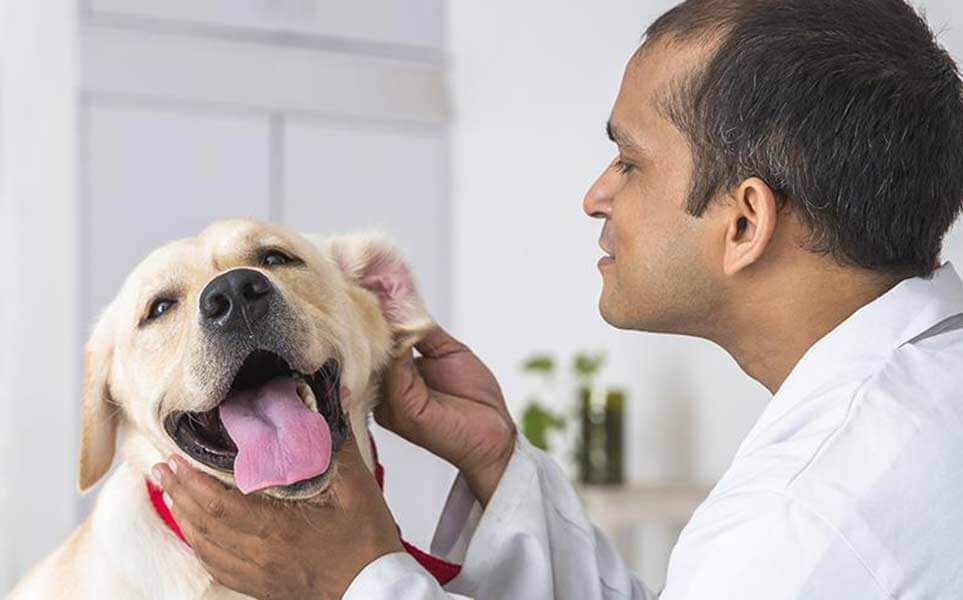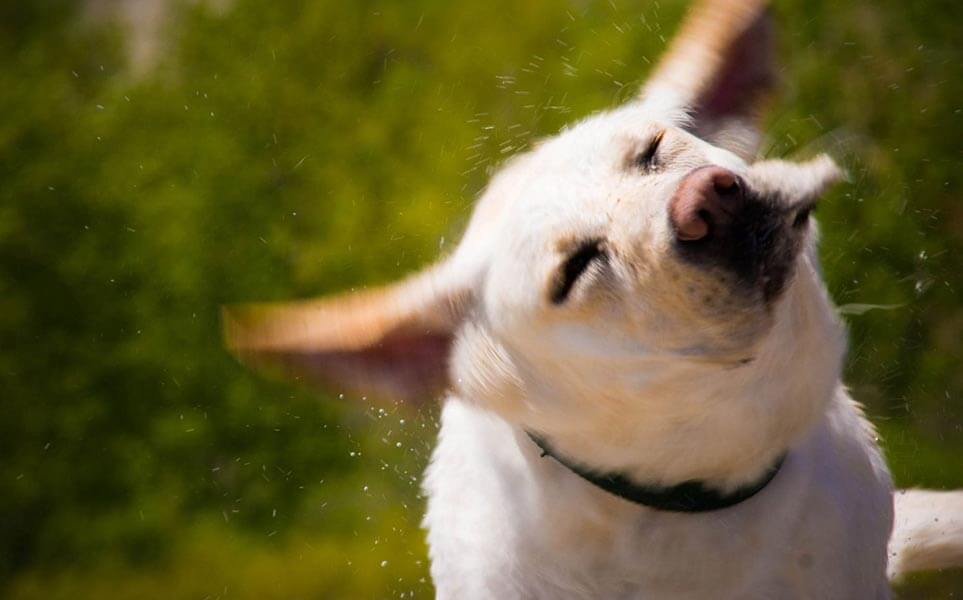It’s normal to see your dog shake his head occasionally. Dogs sometimes shake their heads to remove dirt from their ears or when they’re feeling itchy, but it’s not normal if they’re doing it constantly. What should you do when a labrador won’t stop shaking his head?
When a labrador won’t stop shaking its head, you should look for signs indicating common problems, such as allergies, a foreign object stuck in its ear, or mites. It’s also common for labradors to get ear infections because they have floppy ear flaps that trap moisture and bacteria.
In this article, I’ll explore these and other reasons why your labrador won’t stop shaking its head. I’ll also feature what you can do to solve the problems, such as when to seek treatment from your veterinarian.
Table of Contents
Why Is My Lab Shaking His Head So Much?
One of the most common reasons labs shake their heads excessively is ear infections. This is a common affliction in labradors because this breed of dog has floppy ears that cover the ear canal, turning it into a breeding ground for germs that can cause ear infections.
However, ear infections are just one potential reason why your labrador is experiencing regular head shaking. Let’s explore this and other reasons.
Ear Infections
In a study of labradors published in Canine Medicine and Genetics, the most common complaint from the dogs’ owners was that their labradors experienced ear infections. Chocolate labradors were found to experience the most ear infections, followed by yellow labradors and black labradors.
If your labrador is suffering from an ear infection, it could be shaking its head a lot to try to rid itself of the itchiness or inflammation.
Ear infections will be displayed with common symptoms you’ll see underneath the dog’s ear flap, such as:
- Redness inside the ear
- Discharge that can be brown, yellow, or green in color
- Swelling
- Odor from the ear
- Pawing of the ear
- Scratching the affected ear
How To Stop It
If your dog is displaying signs of an ear infection, you should take it to your veterinarian. Treatment for dog ear infections includes a medicinal ear cleanser and sometimes other medication, such as one that you can apply to your dog’s ears.
If your dog’s ear infection is severe, the vet might prescribe a course of antibiotics to clear it up.
Earwax Buildup
Since labrador ears are floppy, they can trap ear wax. This can accumulate inside the dog’s ear, causing a smelly discharge and proving uncomfortable for your dog.
There are various causes of earwax buildup, including
- Ear infections
- Allergies
A dog that likes to swim is also more likely to experience a lot of earwax.
While it’s normal and healthy for dogs to have earwax as this cleans the dust and debris in the ears, if there’s a lot more earwax than usual, it’s likely there’s a problem. But more important than the amount of earwax is its color and smell.
Healthy dog earwax shouldn’t have an odor and should be pale yellow in color.
How To Stop It
If your labrador has a lot of wax in their ears, you should take them to the vet, who might prescribe medication to treat it, whether the wax has accumulated due to allergies or ear infections.
You can also take proactive measures to prevent your dog from experiencing earwax buildup in the future. This includes cleaning your dog’s ears with an ear cleaner.
I’d recommend Jungle Pet Dog Ear Cleaner Dog Ear Wash for Dogs and Cats, available from Amazon. It reduces wax buildup and eliminates crusts in the ear, preventing infections from occurring.

Water Trapped in the Ear
Although it might seem like a rare occurrence, it’s actually quite common for dogs to get water trapped in their ears. This is because their ear canals are longer than humans’, making it easier for water to get stuck there.
The more a dog comes into contact with water, such as if your dog loves to swim regularly, the more likely it is for water to get trapped in its ears.
If your labrador has some water stuck in its ear, this can cause it to shake its head a lot in an attempt to dislodge the water droplets.
Water trapped in your dog’s ear can be painful and lead to ear infections. If your dog has this problem, you’re likely to notice it displaying other symptoms, such as pawing its ears in an attempt to remove the water.
Alternatively, your dog might rub their ears against the floor or objects such as the coffee table to eliminate the water.
If the water isn’t removed, it can cause an infection.
How To Stop It
Although water trapped in your dog’s ear will usually resolve itself, if you see that your dog is still shaking his head a lot after a few days or showing signs of an ear infection, you’ll have to visit your veterinarian.
However, you can prevent water from getting trapped in your dog’s ear in the future by following these steps after your dog has been swimming in the pool or running through the garden sprinklers.
- Use a towel to dry the outside of your dog’s ears.
- Apply an ear cleaner to soothe the ear. Rub the bottom of your dog’s ear after applying the ear cleaner so that it can be moved into the ear canal.
- Never use a Q-tip to apply the ear cleaner, as this can cause injuries to your dog’s ear.
A Mite Infestation in the Ears
Your labrador might be shaking its head a lot because of a mite infestation in its ears. If this is the case, you’ll notice symptoms such as the following:
- Ear discharge. This is usually darker than your dog’s regular earwax, such as reddish-brown or dark brown.
- Mites are seen inside the ears. These are really tiny, so you’ll need to check for them with a microscope. Ear mites look like moving dots — that’s how small they are!
- Your dog is rubbing their ears.
- Your dog is scratching their ears.
- Skin infections. These can appear around the ears or on their heads or necks. They occur because of how much the dog is scratching itself.
How To Stop It
Book an appointment with your vet if you think your dog has ear mites. He or she will clean your dog’s ear canal and provide you with any of the following treatments, depending on the severity of the ear mites:
- Topical product that gets applied inside the ear.
- Oral medications
- Injections
To prevent ear mites in the future, you can take precautions such as the following:
- Keep your dog’s toys and beddings clean. You should clean them in a washing machine at a minimum of 140°F (60°C). This is a good way to eliminate mites that could still be hanging around your home after your dog’s ears have been infected.
- When taking your dog for a walk, keep it away from other animals that could have ear mites.
The Presence of a Foreign Object in the Ear
If your dog loves to play and run around in the garden, he might get something stuck in his ear. This can cause him to shake his head to try to dislodge it, but he’ll also display other symptoms, such as the following:
- Bloody discharge
- Swollen ears
- Pawing/scratching his ear
- Loss of balance
Grass seeds are a common type of foreign object that can get stuck inside a dog’s ear. Other foreign objects that can get stuck in your dog’s ears include:
- Sticks
- Twigs
- Bugs
- Burrs
How To Stop It
If you can see a foreign object in your dog’s ear, you could try to gently remove it with your fingers or tweezers, but make sure you have someone to keep your dog still so that he doesn’t move suddenly and injure himself.
If you can’t see anything stuck inside your dog’s ear, or it’s showing symptoms such as bleeding and swelling, you should take them to the vet. Make sure to bandage the ear so that it can rest flat against his head to staunch the bleeding and prevent further discomfort or injury to the ear.

Involuntary Head Shaking – Causes and Solutions
The conditions that can cause head shaking in your dog, which we outlined in the previous section, cause voluntary shaking. But there are also types of involuntary head shaking. These include the following conditions.
Canine Distemper Virus
This virus attacks various systems in the dog’s body, such as the nervous system and causes the jerking of muscles. It’s a serious illness that presents with other symptoms, such as:
- Coughing
- Nasal or ocular discharge
- Fever
- Lethargy
- Head circling
- Diarrhea
- Vomiting
- Reduced appetite
- Tilting of the head
- Muscle twitches
- Seizures
If your dog is younger than four months or hasn’t been vaccinated against canine distemper, it has a greater risk of getting this disease.
How To Stop It
Although there’s no cure for canine distemper virus, supportive care must be given to the dog to manage its symptoms. Fluids should also be given to the dog to prevent dehydration. It’s also essential for dogs suffering from canine distemper virus to be isolated so that they don’t spread the virus to other dogs.
Cerebellar Hypoplasia
This is a type of cerebral palsy condition that affects dogs. It’s always present in affected dogs at birth and develops as they grow. It includes a variety of symptoms, such as:
- Tremors
- Head bobbing
- Ataxia
- Falling over
How To Stop It
Although this condition can’t be cured because it is defined as the brain not developing properly, dogs don’t experience a progression of symptoms, so they can lead a healthy, normal lifespan.
Idiopathic Head Tremors
These head tremors present with symptoms such as:
- Shaking head
- Shaking head up and down
- Head bobbing
They can arise from a variety of causes, such as:
- Trauma to the head
- Pain
- Low blood sugar
- Chemical toxins
- Brain swelling
- Central nervous system disease
- Low calcium
- Kidney conditions
In some cases, there’s no known cause for idiopathic head tremors. In this case, no treatment for it will be provided, and the tremors won’t worsen over time and could even disappear.
How To Stop It
Your dog’s veterinarian will treat these tremors after identifying their cause, so tests will have to be conducted to find out what’s causing your dog to experience involuntary head shaking.
For example, if your dog has consumed chemicals, the vet will give it an emetic so that it can throw it up. By comparison, if the vet diagnoses a kidney condition, medication or surgery might be recommended.
Dog Head Shaking: When To Call a Vet
If your dog shakes his head once in a while or after a specific behavior, such as after swimming, this isn’t a reason to call your vet. However, it’s worth making that call if the head shaking persists.
This is because head shaking itself can cause secondary problems for your dog, such as the following:
- Blood blisters. This is because the head shaking can burst blood vessels. This fills the dog’s ear flap with blood that can cause a blood blister called an aural hematoma.
- Wounds. The outer part of the ear can get damaged if your dog is persistently shaking his head hard. This causes the ears to make contact with the neck and head, leading to cuts and wounds.
Final Thoughts
If your labrador won’t stop shaking his head, it could be the result of a variety of factors and health conditions. Some causes are easy to treat, such as allergies or a foreign object that’s stuck in the dog’s ear, while others can be more serious, such as when it comes to viruses or the ingestion of chemicals.
Before taking a step to resolve the issue, it’s crucial to properly identify what’s causing it. Unless you’re certain of the cause, it’s best to consult your vet. Better safe than sorry!




